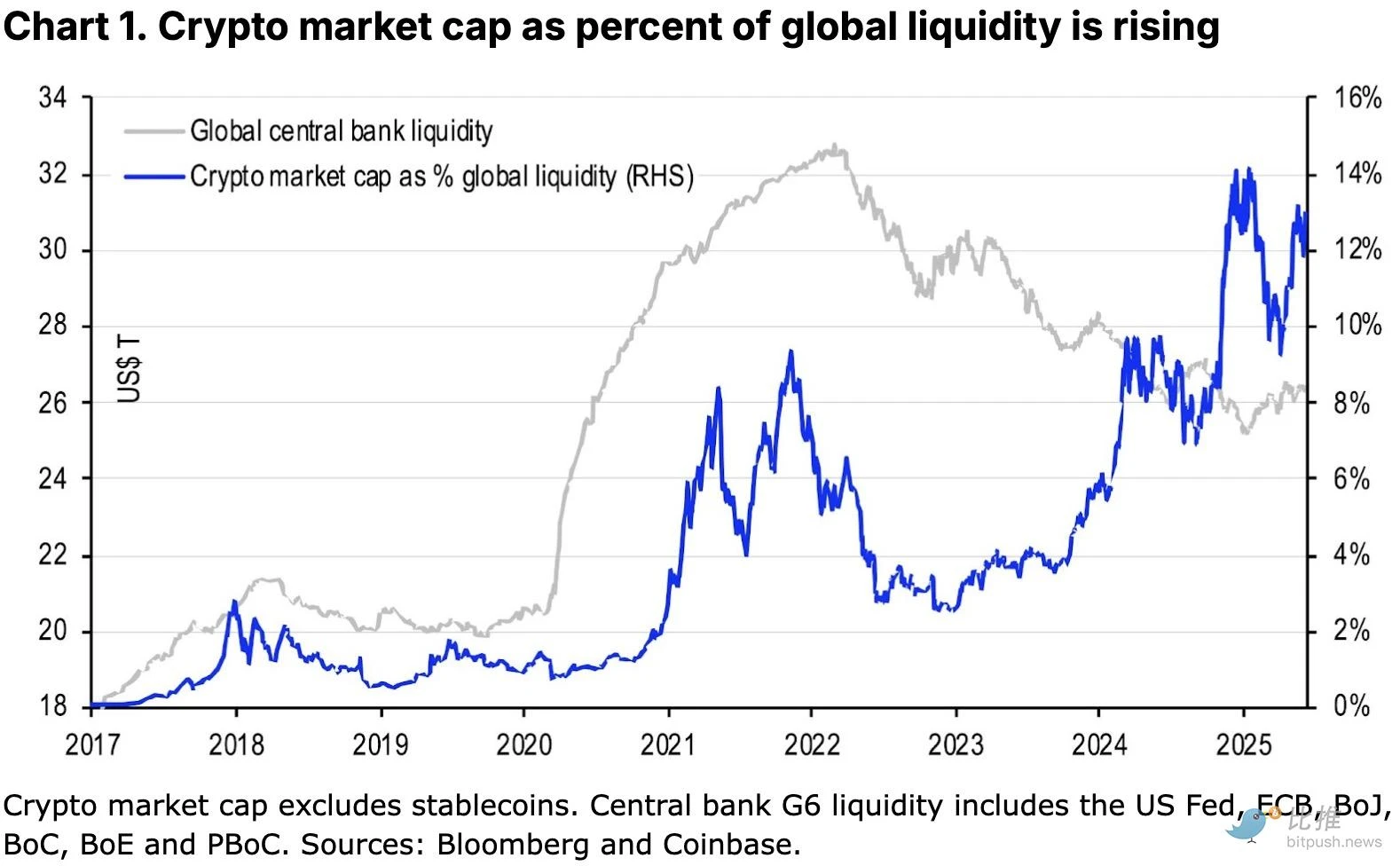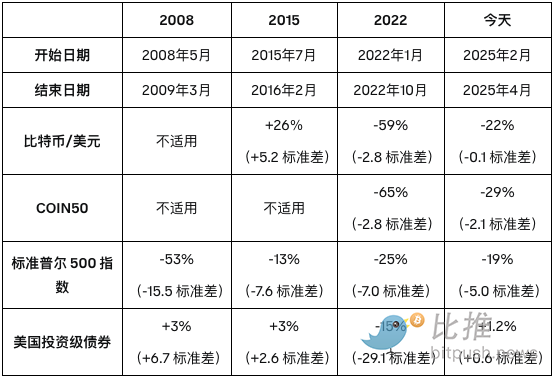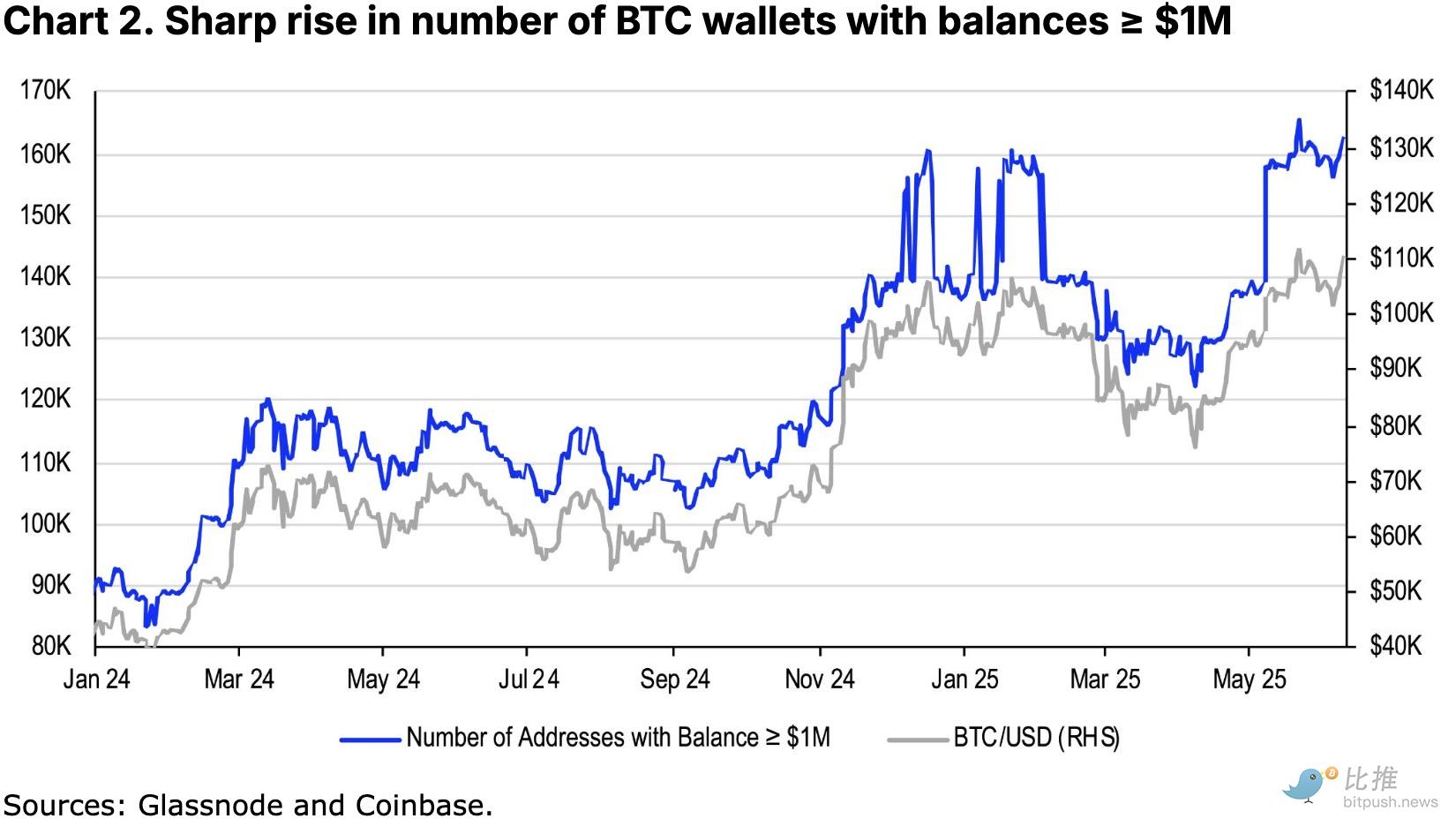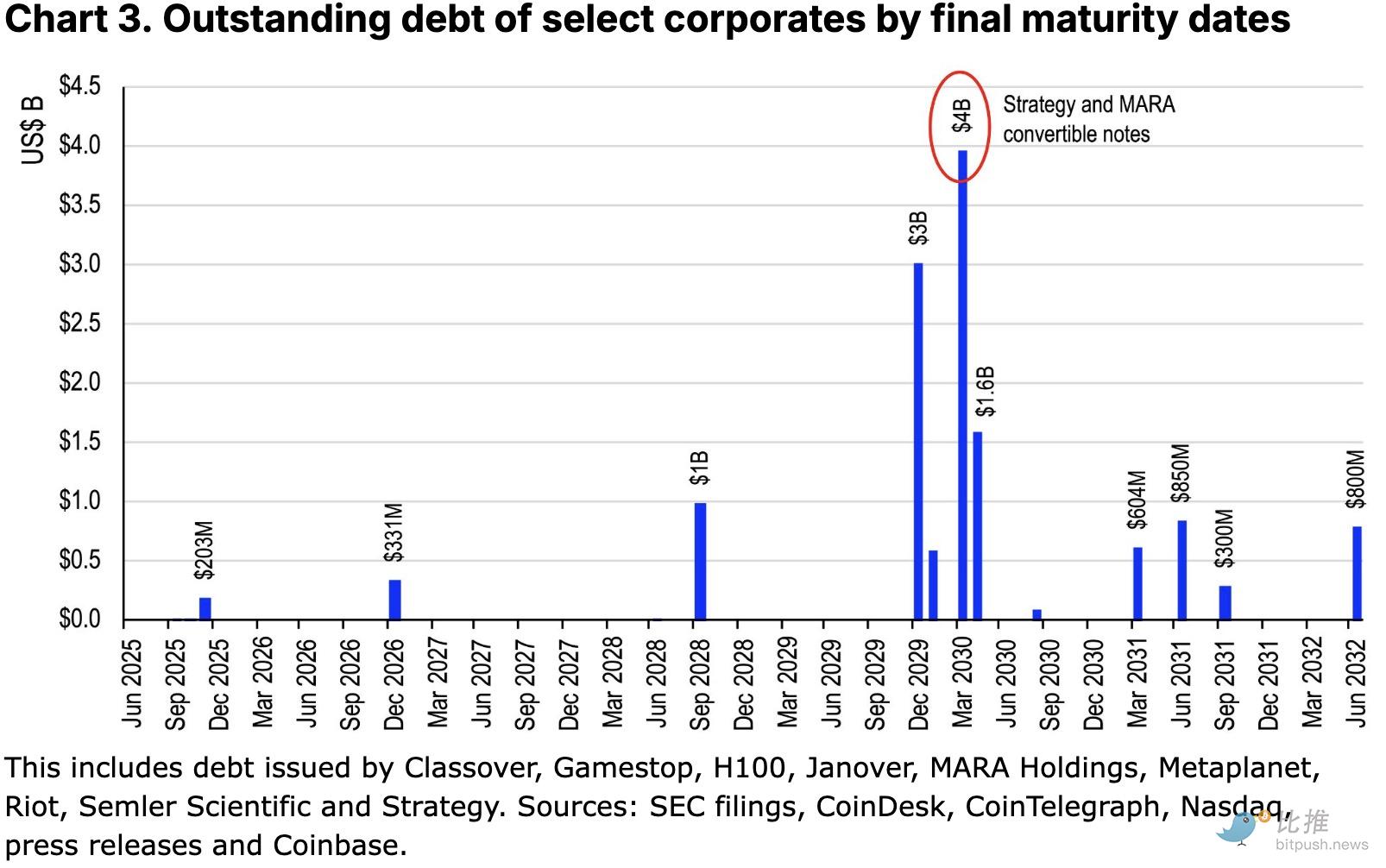Original Author: David Duong
Compiled and Organized by: BitpushNews
The trend of companies financing the purchase of crypto assets with leverage may pose systemic risks in the medium to long term, such as forced selling or motivation-driven selling, but we believe that the risks are still manageable in the short term.
The regulatory environment in the United States is undergoing positive changes, with stablecoin legislation advancing and discussions ongoing regarding crypto market structure legislation.
Our constructive outlook for the crypto market in the second half of 2025 is based on several core factors: a more optimistic outlook for U.S. economic growth, potential interest rate cuts by the Federal Reserve, increased corporate adoption of cryptocurrencies, and clearer U.S. regulations.
While there are still some potential risks, such as a steepening U.S. Treasury yield curve and selling pressure triggered by listed crypto instruments, we believe these risks are manageable in the short term.
We identify three key themes for the crypto market in the second half of the year:
Improvement in macro outlook: The risk of a U.S. recession has significantly decreased, and overall growth momentum has strengthened;
Corporate adoption of crypto as an asset allocation tool: While this may pose systemic risks in the long term, it creates strong demand in the short term;
Regulatory clarity: Particularly the progress in stablecoin and crypto market structure legislation will profoundly impact the development of the crypto ecosystem.
Despite the risks, we still expect Bitcoin to maintain an upward trend, while the performance of altcoins may depend more on individual factors.
For example, the SEC is reviewing multiple ETF applications involving "physical creation and redemption," staking, fund-of-funds, and single altcoin ETFs, with decisions expected by the end of 2025, which may reshape market structure.
Market Outlook: Second Half of 2025
We maintain our previous forecast that the first half of 2025 will be the bottom for the crypto market, with the second half potentially reaching historical highs.
Despite Bitcoin's rebound at the end of May, we still believe there may be further upside in the next 3-6 months.
In our view, the macro disturbances caused by trade tariffs are nearing their end. Looking ahead, as the government pushes for more market-friendly fiscal legislation (expected to be completed by late summer), risk appetite is likely to recover. 
However, one notable risk is that this fiscal spending bill may lead to a steepening of the U.S. Treasury yield curve, particularly in the 10-30 year segment.
In fact, due to concerns over the deficit, the yield on the 30-year U.S. Treasury bond rose to 5.15% in May, reaching a 20-year high. This could exacerbate financial tightening, increasing financing costs for businesses and consumers, thereby weakening the growth foundation and affecting market confidence.
If long-term yields rise too quickly, it could trigger volatility in the stock and credit markets, especially if investors begin to doubt whether the U.S. can sustain high deficits without triggering systemic risks.
This development path would challenge the current narrative of "front-loaded fiscal stimulus" or force the market to reassess risk assets earlier, particularly if economic data or Federal Reserve policies do not meet expectations.
At the same time, we believe this could also benefit store-of-value assets like gold and Bitcoin, especially in the context of a weakening dollar dominance.
Three Key Themes
Theme 1: The Shadow of Recession Has Significantly Diminished
At the beginning of the year, trade disturbances raised concerns that the U.S. would fall into a technical recession, especially after the GDP contracted at an annualized rate of 0.2% in the first quarter of 2025.
Mainstream media, including The Economist and The Wall Street Journal, issued warnings such as "Trump's tariff war could trigger a global recession" and "Trump's reciprocal tariffs could ignite a U.S. recession."
However, we have maintained a relatively optimistic outlook for the second half of the year. We believe that the "degree" of recession is key; a technical recession may not have a profound impact on the market unless macro momentum continues to deteriorate.
For example, during the 2008 financial crisis, U.S. stocks fell by 53%, while the "recessions" in 2015 and 2022 were much milder (see the table below). Additionally, the Atlanta Fed's GDPNow forecasting model has been significantly revised upward from a 1.0% annualized growth rate in early May to 3.8% on June 5, reflecting improved economic data.
We therefore judge that even if a slowdown occurs in 2025, it is more likely to be a mild recession or "soft landing," rather than a severe recession or stagflation scenario.
Even so, the market impact may be limited to specific sectors rather than a broad sell-off. Coupled with the expansion of the U.S. M2 money supply and global central bank balance sheets, we believe the probability of asset prices returning to 2024 levels is low. The upward trend in Bitcoin is expected to continue. Furthermore, most of the "tariff shocks" have already been absorbed by the market, and while there are still some pending policies (such as the expiration of the reciprocal tariff suspension on July 9), the overall marginal risk is diminishing.
Comparison of cyclical declines in various assets (from peak to trough):

Theme 2: The Wave of Corporate Adoption of Crypto Assets - Is the "Replica Strategy" Coming?
Currently, approximately 228 publicly traded companies globally hold a total of 820,000 BTC. Among them, about 20 (along with another 8 holding ETH, SOL, and XRP) are using a leveraged financing approach similar to "Strategy (formerly MicroStrategy)."
The new FASB accounting standards, effective December 15, 2024, significantly promote the inclusion of crypto assets on corporate balance sheets.
Previously, U.S. Generally Accepted Accounting Principles (GAAP) only allowed companies to account for impairments of crypto assets on their books, while gains could only be recognized upon sale.
The new rules allow for fair value disclosure, making financial statements more comparable and providing higher transparency for CFOs and auditors.

However, we observe that a new trend is emerging - an increasing number of publicly traded companies are becoming "coin-holding machines," with their core business being the purchase of crypto assets.
They finance their coin purchases through issuing stocks or convertible bonds, with market capitalizations far exceeding their net assets. A representative example is Strategy, but now more imitators are emerging.
Two potential systemic risks:
Forced selling: Many PTCVs (publicly traded crypto asset vehicles) rely on convertible bond financing; if the price of the underlying coins falls, or if the market environment deteriorates and refinancing fails, these companies may have to sell their crypto assets to repay debts.
Motivated selling: If a PTCV suddenly sells assets due to operational or cash flow management needs, it could trigger a chain reaction, spreading market panic and causing a price collapse.
Nevertheless, we believe that these risks are not sufficient to pose a significant shock to the market in the short term. First, most debts will not mature until 2029-2030 (for example, Strategy's $3 billion convertible bond has its first redemption period at the end of 2026 and matures at the end of 2029), so the short-term selling risk is low. Second, the current loan-to-value (LTV) ratios are generally healthy, and some large companies have the ability to avoid forced sales through refinancing.

Of course, as more companies adopt this strategy and debts come due, systemic risks will still warrant long-term monitoring. The "corporate coin-holding model" of Strategy is also attracting more "curious" executive teams, indicating that the trend of corporate hoarding of coins will continue into the second half of 2025.
Theme 3: A New Era of Regulation Begins
In the first half of 2025, U.S. crypto policy underwent unprecedented changes. The White House abandoned the old path of "regulation by enforcement" and fully shifted to supporting the development of the crypto industry.
We believe that stablecoin legislation is most likely to be implemented first. Currently, the House of Representatives is advancing the STABLE Act, while the Senate is pushing the GENIUS Act, both of which have received bipartisan support.
On June 11, the Senate passed the GENIUS Act, sending it to the House for consideration. Both bills set reserve requirements, anti-money laundering compliance, bankruptcy protection, and consumer rights provisions.
The main points of contention are:
How to handle non-U.S. stablecoin issuers
How to set regulatory thresholds
The White House is expected to complete a unified version of the bill for presidential signature before Congress recesses on August 4, which may lay the groundwork for subsequent market structure legislation.
Crypto Market Structure Legislation (CLARITY Act)
On May 29, 2025, the U.S. House Financial Services Committee officially proposed the draft of the "Digital Asset Market Clarity Act (CLARITY Act)," which is considered the most transformative legislation of the year.
The bill aims to clarify the regulatory boundaries of the SEC and CFTC regarding crypto assets and to categorize regulation based on asset attributes (such as "digital commodities" or "investment contracts"). This bill builds on the FIT21 Act passed last year and requires the SEC and CFTC to jointly define key terms and continue rule-making, indicating that there is still room for evolution in regulatory division of labor.
We believe this will serve as the basis for future negotiations between the two chambers, but its complexity and uncertainty will be higher than that of stablecoin legislation.
ETF Progress Timeline
In 2025, the SEC is facing approximately 80 crypto ETF proposals, covering:
Multi-asset crypto index funds (Bitwise, Franklin, Grayscale, etc.): Decisions as early as July 2;
Physical creation/redemption (in-kind) mechanism: Results may come in July, but at the latest by October;
Staking inclusion: Subject to the transparency of Rule 6c-11, the SEC may make decisions earlier;
Single altcoin ETFs: Most application deadlines are in October, and the SEC is expected to use the entire review period.
Conclusion
We hold an optimistic view of the cryptocurrency market in the third quarter of 2025, thanks to a relatively optimistic outlook for U.S. economic growth, potential interest rate cuts by the Federal Reserve, increased corporate adoption of cryptocurrencies, and improved regulatory transparency in the U.S.
While there are risks such as a steepening U.S. Treasury yield curve and potential selling pressure from PTCVs, these remain manageable in the short term. We believe the upward trend in Bitcoin will continue, although the performance of altcoins will need to be assessed based on individual projects.
免责声明:本文章仅代表作者个人观点,不代表本平台的立场和观点。本文章仅供信息分享,不构成对任何人的任何投资建议。用户与作者之间的任何争议,与本平台无关。如网页中刊载的文章或图片涉及侵权,请提供相关的权利证明和身份证明发送邮件到support@aicoin.com,本平台相关工作人员将会进行核查。




